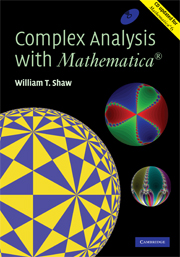Book contents
- Frontmatter
- Contents
- Preface
- 1 Why you need complex numbers
- 2 Complex algebra and geometry
- 3 Cubics, quartics and visualization of complex roots
- 4 Newton—Raphson iteration and complex fractals
- 5 A complex view of the real logistic map
- 6 The Mandelbrot set
- 7 Symmetric chaos in the complex plane
- 8 Complex functions
- 9 Sequences, series and power series
- 10 Complex differentiation
- 11 Paths and complex integration
- 12 Cauchy's theorem
- 13 Cauchy's integral formula and its remarkable consequences
- 14 Laurent series, zeroes, singularities and residues
- 15 Residue calculus: integration, summation and the argument principle
- 16 Conformal mapping I: simple mappings and Möbius transforms
- 17 Fourier transforms
- 18 Laplace transforms
- 19 Elementary applications to two-dimensional physics
- 20 Numerical transform techniques
- 21 Conformal mapping II: the Schwarz—Christoffel mapping
- 22 Tiling the Euclidean and hyperbolic planes
- 23 Physics in three and four dimensions I
- 24 Physics in three and four dimensions II
- Bibliograpy
- Index
21 - Conformal mapping II: the Schwarz—Christoffel mapping
Published online by Cambridge University Press: 05 August 2014
- Frontmatter
- Contents
- Preface
- 1 Why you need complex numbers
- 2 Complex algebra and geometry
- 3 Cubics, quartics and visualization of complex roots
- 4 Newton—Raphson iteration and complex fractals
- 5 A complex view of the real logistic map
- 6 The Mandelbrot set
- 7 Symmetric chaos in the complex plane
- 8 Complex functions
- 9 Sequences, series and power series
- 10 Complex differentiation
- 11 Paths and complex integration
- 12 Cauchy's theorem
- 13 Cauchy's integral formula and its remarkable consequences
- 14 Laurent series, zeroes, singularities and residues
- 15 Residue calculus: integration, summation and the argument principle
- 16 Conformal mapping I: simple mappings and Möbius transforms
- 17 Fourier transforms
- 18 Laplace transforms
- 19 Elementary applications to two-dimensional physics
- 20 Numerical transform techniques
- 21 Conformal mapping II: the Schwarz—Christoffel mapping
- 22 Tiling the Euclidean and hyperbolic planes
- 23 Physics in three and four dimensions I
- 24 Physics in three and four dimensions II
- Bibliograpy
- Index
Summary
Introduction
In Chapter 16 we explored some of the geometrical properties of holomorphic functions, and in particular looked at the behaviour of the Möbius transformation. The key geometrical feature was that the mapping is conformal (where the derivative is non-zero) in the sense that it is locally angle-preserving. In Chapter 19 we highlighted the importance of conformal mapping to the solution of Laplace's equation in two dimensions. We produced several types of solution to Laplace's equation, including several examples where the region of interest was bounded by a circle or a line in the complex plane.
A question that arise naturally is how to manage matters when the region is not a half-plane or interior/exterior of a circle. Here we must draw a sharp distinction between issues of general principle and practicalities of implementation. We shall begin by stating without proof an important, but non-constructive, theorem that addresses the general principle. Then we shall introduce the Schwarz—Christoffel (SC) mapping that gives an explicit construction for polygonal regions.
There are very few examples of the SC mapping that can be worked out in closed-form in terms of ‘simple’ functions. A novel use of Mathematica is to use its advanced built-in special-function capabilities, and their linkage to the symbolic integrator, to give evaluations of several expressions usually left as complicated integrals in more traditional treatments. We can use such evaluations to facilitate the visualization of the mappings, and hence to confirm the correctness of the answer.
- Type
- Chapter
- Information
- Complex Analysis with MATHEMATICA® , pp. 451 - 472Publisher: Cambridge University PressPrint publication year: 2006



